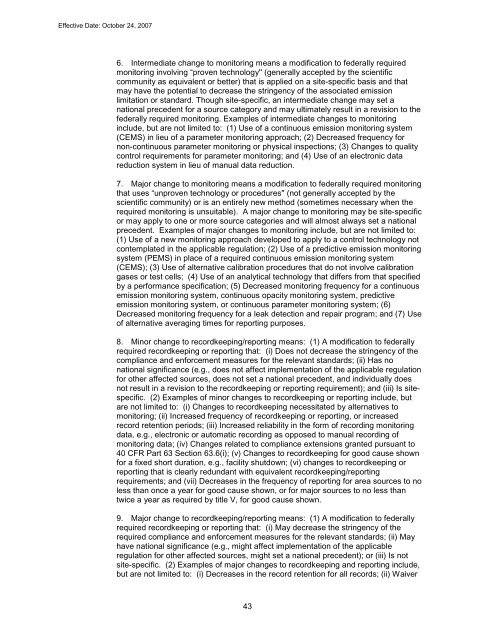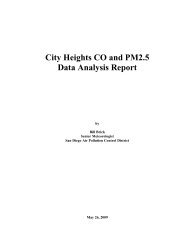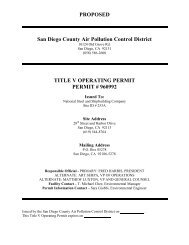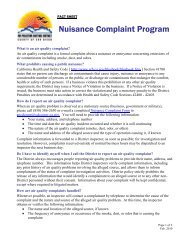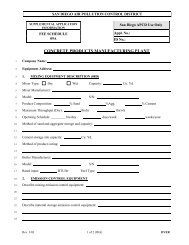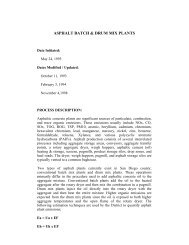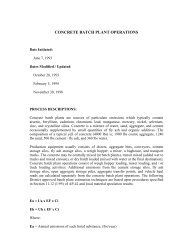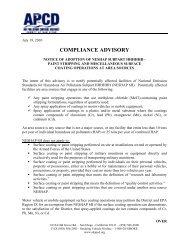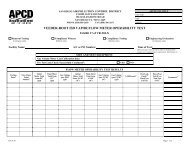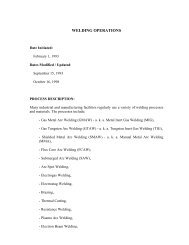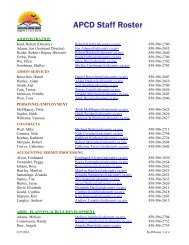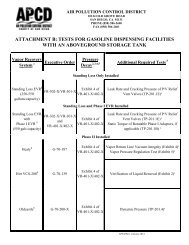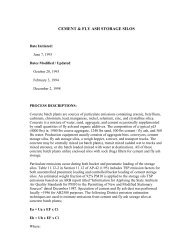Effective Date: October 24, 2007(2) Examples of minor changes to a test method include, but are not limited to:(i) Field adjustments in a test method's sampling procedure, such as a modifiedsampling traverse or location to avoid interference from an obstruction in the stack,increasing the sampling time or volume, use of additional impingers <strong>for</strong> a highmoisture situation, accepting particulate emission results <strong>for</strong> a test run that wasconducted with a lower than specified temperature, substitution of a material in thesampling train that has been demonstrated to be more inert <strong>for</strong> the sample matrix;<strong>and</strong> (ii) Changes in recovery <strong>and</strong> analytical techniques such as a change in qualitycontrol/quality assurance requirements needed to adjust <strong>for</strong> analysis of a certainsample matrix.3. Intermediate change to test method means a within-method modification to afederally en<strong>for</strong>ceable test method involving “proven technology'' (generally acceptedby the scientific community as equivalent or better) that is applied on a site-specificbasis <strong>and</strong> that may have the potential to decrease the stringency of the associatedemission limitation or st<strong>and</strong>ard. Though site-specific, an intermediate change may seta national precedent <strong>for</strong> a source category <strong>and</strong> may ultimately result in a revision tothe federally en<strong>for</strong>ceable test method. In order to be approved, an intermediatechange must be validated according to U.S. EPA Method 301 (40 CFR Part 63,Appendix A) to demonstrate that it provides equal or improved accuracy <strong>and</strong>precision. Examples of intermediate changes to a test method include, but are notlimited to: (1) Modifications to a test method's sampling procedure includingsubstitution of sampling equipment that has been demonstrated <strong>for</strong> a particularsample matrix, <strong>and</strong> use of a different impinger absorbing solution; (2) Changes insample recovery procedures <strong>and</strong> analytical techniques, such as changes to sampleholding times <strong>and</strong> use of a different analytical finish with proven capability <strong>for</strong> theanalyte of interest; <strong>and</strong> (3) “Combining'' a federally required method with anotherproven method <strong>for</strong> application to processes emitting multiple pollutants.4. Major change to test method means a modification to a federally en<strong>for</strong>ceable testmethod that uses “unproven technology or procedures'' (not generally accepted bythe scientific community) or is an entirely new method (sometimes necessary whenthe required test method is unsuitable). A major change to a test method may be sitespecific,or may apply to one or more sources or source categories, <strong>and</strong> will almostalways set a national precedent. In order to be approved, a major change must bevalidated according to EPA Method 301 (40 CFR Part 63, Appendix A). Examples ofmajor changes to a test method include, but are not limited to: (1) Use of anunproven analytical finish; (2) Use of a method developed to fill a test method gap;(3) Use of a new test method developed to apply to a control technology notcontemplated in the applicable regulation; <strong>and</strong> (4) Combining two or moresampling/analytical methods (at least one unproven) into one <strong>for</strong> application toprocesses emitting multiple pollutants.5. Minor change to monitoring means: (1) A modification to federally requiredmonitoring that: (i) Does not decrease the stringency of the compliance <strong>and</strong>en<strong>for</strong>cement measures <strong>for</strong> the relevant st<strong>and</strong>ard; (ii) Has no national significance(e.g., does not affect implementation of the applicable regulation <strong>for</strong> other affectedsources, does not set a national precedent, <strong>and</strong> individually does not result in arevision to the monitoring requirements); <strong>and</strong> (iii) Is site-specific, made to reflect oraccommodate the operational characteristics, physical constraints, or safetyconcerns of an affected source. (2) Examples of minor changes to monitoringinclude, but are not limited to: (i) Modifications to a sampling procedure, such as useof an improved sample conditioning system to reduce maintenance requirements; (ii)Increased monitoring frequency; <strong>and</strong> (iii) Modification of the environmental shelter tomoderate temperature fluctuation <strong>and</strong> thus protect the analytical instrumentation.42
Effective Date: October 24, 20076. Intermediate change to monitoring means a modification to federally requiredmonitoring involving “proven technology'' (generally accepted by the scientificcommunity as equivalent or better) that is applied on a site-specific basis <strong>and</strong> thatmay have the potential to decrease the stringency of the associated emissionlimitation or st<strong>and</strong>ard. Though site-specific, an intermediate change may set anational precedent <strong>for</strong> a source category <strong>and</strong> may ultimately result in a revision to thefederally required monitoring. Examples of intermediate changes to monitoringinclude, but are not limited to: (1) Use of a continuous emission monitoring system(CEMS) in lieu of a parameter monitoring approach; (2) Decreased frequency <strong>for</strong>non-continuous parameter monitoring or physical inspections; (3) Changes to qualitycontrol requirements <strong>for</strong> parameter monitoring; <strong>and</strong> (4) Use of an electronic datareduction system in lieu of manual data reduction.7. Major change to monitoring means a modification to federally required monitoringthat uses “unproven technology or procedures'' (not generally accepted by thescientific community) or is an entirely new method (sometimes necessary when therequired monitoring is unsuitable). A major change to monitoring may be site-specificor may apply to one or more source categories <strong>and</strong> will almost always set a nationalprecedent. Examples of major changes to monitoring include, but are not limited to:(1) Use of a new monitoring approach developed to apply to a control technology notcontemplated in the applicable regulation; (2) Use of a predictive emission monitoringsystem (PEMS) in place of a required continuous emission monitoring system(CEMS); (3) Use of alternative calibration procedures that do not involve calibrationgases or test cells; (4) Use of an analytical technology that differs from that specifiedby a per<strong>for</strong>mance specification; (5) Decreased monitoring frequency <strong>for</strong> a continuousemission monitoring system, continuous opacity monitoring system, predictiveemission monitoring system, or continuous parameter monitoring system; (6)Decreased monitoring frequency <strong>for</strong> a leak detection <strong>and</strong> repair program; <strong>and</strong> (7) Useof alternative averaging times <strong>for</strong> reporting purposes.8. Minor change to recordkeeping/reporting means: (1) A modification to federallyrequired recordkeeping or reporting that: (i) Does not decrease the stringency of thecompliance <strong>and</strong> en<strong>for</strong>cement measures <strong>for</strong> the relevant st<strong>and</strong>ards; (ii) Has nonational significance (e.g., does not affect implementation of the applicable regulation<strong>for</strong> other affected sources, does not set a national precedent, <strong>and</strong> individually doesnot result in a revision to the recordkeeping or reporting requirement); <strong>and</strong> (iii) Is sitespecific.(2) Examples of minor changes to recordkeeping or reporting include, butare not limited to: (i) Changes to recordkeeping necessitated by alternatives tomonitoring; (ii) Increased frequency of recordkeeping or reporting, or increasedrecord retention periods; (iii) Increased reliability in the <strong>for</strong>m of recording monitoringdata, e.g., electronic or automatic recording as opposed to manual recording ofmonitoring data; (iv) Changes related to compliance extensions granted pursuant to40 CFR Part 63 Section 63.6(i); (v) Changes to recordkeeping <strong>for</strong> good cause shown<strong>for</strong> a fixed short duration, e.g., facility shutdown; (vi) changes to recordkeeping orreporting that is clearly redundant with equivalent recordkeeping/reportingrequirements; <strong>and</strong> (vii) Decreases in the frequency of reporting <strong>for</strong> area sources to noless than once a year <strong>for</strong> good cause shown, or <strong>for</strong> major sources to no less thantwice a year as required by title V, <strong>for</strong> good cause shown.9. Major change to recordkeeping/reporting means: (1) A modification to federallyrequired recordkeeping or reporting that: (i) May decrease the stringency of therequired compliance <strong>and</strong> en<strong>for</strong>cement measures <strong>for</strong> the relevant st<strong>and</strong>ards; (ii) Mayhave national significance (e.g., might affect implementation of the applicableregulation <strong>for</strong> other affected sources, might set a national precedent); or (iii) Is notsite-specific. (2) Examples of major changes to recordkeeping <strong>and</strong> reporting include,but are not limited to: (i) Decreases in the record retention <strong>for</strong> all records; (ii) Waiver43
- Page 4 and 5: Effective Date: October 24, 2007con
- Page 6 and 7: Effective Date: October 24, 2007she
- Page 8 and 9: Effective Date: October 24, 2007(37
- Page 11 and 12: Effective Date: October 24, 2007(53
- Page 13 and 14: Effective Date: October 24, 2007(A)
- Page 15 and 16: Effective Date: October 24, 2007Met
- Page 17 and 18: Effective Date: October 24, 2007(B)
- Page 19 and 20: Effective Date: October 24, 2007(5)
- Page 21 and 22: Effective Date: October 24, 2007(4)
- Page 23 and 24: Effective Date: October 24, 2007(b)
- Page 25 and 26: Effective Date: October 24, 2007(1)
- Page 27 and 28: Effective Date: October 24, 2007(b)
- Page 29 and 30: Effective Date: October 24, 200745
- Page 31 and 32: Effective Date: October 24, 2007Chr
- Page 33 and 34: Effective Date: October 24, 2007(d)
- Page 35 and 36: Effective Date: October 24, 2007(6)
- Page 37 and 38: Effective Date: October 24, 2007tes
- Page 39 and 40: Effective Date: October 24, 20073.
- Page 41: Effective Date: October 24, 2007Tab
- Page 45 and 46: Effective Date: October 24, 2007App
- Page 47 and 48: Effective Date: October 24, 2007b)
- Page 49 and 50: Effective Date: October 24, 200711.
- Page 51 and 52: Effective Date: October 24, 2007App
- Page 53 and 54: Effective Date: October 24, 2007San
- Page 55 and 56: Effective Date: October 24, 2007App
- Page 57: Effective Date: October 24, 2007App


